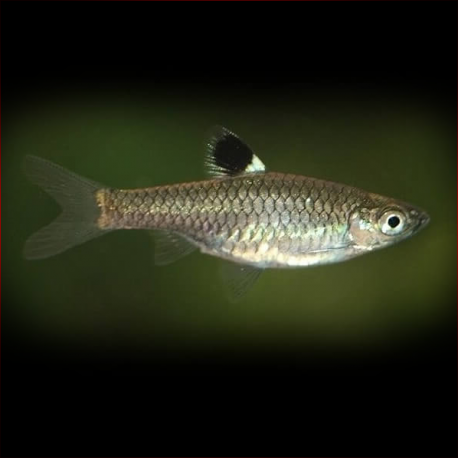More info
Datasheet
| Minimum Tank Size | 80 litres / 21.13 US gallons |
| Maximum Size | 4.3cm / 1.69inches |
| Temperature | 20°C / 68.00°F - 25°C / 77.00°F |
| Hardness | 2.02dgH / 36ppm - 12.05dgH / 215ppm |
| pH | 6.0-7.5 |
General Description
Rasbora dorsinotata, commonly known as the Rasbora Dorsinotata, is a member of the Cyprinidae family, belonging to the classification order Cypriniformes. The species is distinguishable by its specific physical characteristics, such as a dorsal fin with a black tip and a black lateral stripe extending from the opercle to the posterior half of the caudal peduncle, ending in a rounded spot. This fish typically reaches a maximum size of around 4.3 cm and is native to the Mekong and upper Chao Phraya river basins in northern Thailand and northern Laos.
Aquarium Setup
Maintaining R. dorsinotata in captivity necessitates an aquarium setup resembling a flowing stream or river. It is suggested to replicate the natural habitat using variably-sized water-worn rocks, sand, fine gravel, and small boulders. Aquatic plants like Microsorum, Bolbitis, or Anubias spp. can be added, with a preference for hardy varieties. The species thrives in well-oxygenated water that is regularly cleaned, with a pH range of 6.0-7.5, hardness between 36-215ppm, and a temperature of 20-25°C (see table).
Behaviour
This species is known to exhibit peaceful behavior, making it an excellent addition to a larger, well-furnished community tank. R. dorsinotata is gregarious and should ideally be kept in groups of at least six individuals to promote vibrant colors, confidence, and natural behavior. It is recommended to house them with suitable tankmates like Acantopsis choirorhynchos, Yasuhikotakia sidthimunki, and other compatible species from the Chao Phraya river region.
Feeding and Diet
R. dorsinotata likely feeds on aquatic and terrestrial invertebrates in its natural habitat. In captivity, they can be fed dried foods of suitable sizes, but offering daily meals of small live and frozen fare such as Daphnia and bloodworms enhances their coloration and induces breeding behavior.
Reproduction & Dimorphism
Reproduction in R. dorsinotata is not thoroughly documented, but it is presumed to be similar to other Rasbora species. They are egg-scattering free spawners without parental care. Mature females are typically larger and rounder-bellied compared to males. To maximize breeding success, a controlled breeding setup involving conditioned adult pairs and specialized breeding tanks with optimal water conditions is recommended.
Habitat and Distribution
The Rasbora Dorsinotata species is confined to smaller tributaries with clear, flowing water in the Mekong and upper Chao Phraya river basins in northern Thailand and northern Laos. They are commonly found in abundance in these habitats, displaying a preference for smaller tributaries over main river channels.

